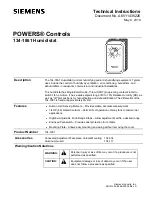
Technical Instructions
POWERS Controls 134-1861 Humidistat
Document Number A6V11435226
May 9, 2019
Page 2
Siemens Industry, Inc.
Introduction
The 134-1861 Humidistat provides SPDT control for use on low or line voltage
applications. It has a thermoplastic cover with an Allen-head locking screw to discourage
unauthorized tampering. The sensing element consists of carefully selected and
processed human hair.
An adjusting knob and easy-to-read dial allow quick selection of the desired setpoint. The
humidistat is supplied with the faceplate installed for vertical mounting and knob
adjustment. However, a horizontal faceplate is enclosed for horizontal mounting and
knob adjustment if desired. There is also an optional Concealed Adjustment Faceplate
(P/N 134-034) available for installations where humidity adjustment by the occupants is
not desired.
WARNING:
The low temperature detection thermostat is designed for use only as an
operating control. Where an operating control failure would result in
personal injury and/or loss of property, it is the responsibility of the
installer to add devices (safety, limit controls) or systems (alarm,
supervisory systems) that protect against, or warn of control failure.
Operation
The humidistat has a setpoint range of 0 to 70% RH, as well as humidification off (
HUM
OFF
) and dehumidification off (
DEH OFF
) positions. At the
HUM OFF
position, the C to L
terminal circuit is open and the C to H terminal circuit is closed. At the
DEH OFF
position,
the C to H terminal circuit is open and the C to L terminal controls the humidification
equipment.
At any given setpoint, the C to L circuit closes on a decrease in relative humidity, and the
C to H circuit closes on an increase in relative humidity.
The usual setting in winter is 30 to 40% RH. Lower settings may be necessary in
extremely cold weather to prevent condensation on windows, doors, and so on. The
same setting should be used where reduction of humidity by means of exhaust fans is
provided in well-constructed homes. Summer settings on air conditioning or
dehumidifying equipment will usually be near 50% RH.
The suggested indoor humidity at 70
F (21
C) for residential applications on humidifying
or dehumidifying equipment in winter is shown in Table 1.
Table 1. Humidity Settings.
Outside Temperature
Suggested Humidity Setting
-20
F (-29
C) and Below
15% RH
-10
F (-23
C)
20% RH
0
F (-18
C)
25% RH
10
F (-12
C)
30% RH
20
F (-7
C)
35% RH
Above 20
F (-7
C)
40% RH or Higher as Desired








